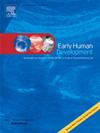The effectiveness of pulmonary hypertension screening in infants born preterm
IF 2.2
3区 医学
Q2 OBSTETRICS & GYNECOLOGY
引用次数: 0
Abstract
Objective
To determine if pulmonary hypertension (PH) screening in at-risk infants born preterm reduces morbidity and/or NICU length of stay.
Study design
This single-center retrospective cohort chart review compared infants born <32 weeks gestational age (GA) before and after the implementation of an updated PH screening guideline. Screening eligibility and PH diagnosis were determined by applying the standardized criteria to patients in both epochs. NICU and post-discharge outcomes were determined by chart review.
Results
Pre- (N = 513) and post-screening (N = 544) epochs had similar gestational age and demographic characteristics. More echocardiograms were obtained in post-screening infants resulting in more PH diagnoses (11.5 % vs. 16.5 %, p = 0.02) at a younger median post-natal age [day of life 73 (28–193) vs. 55 (28–212), median and range, p = 0.01]. PH+ infants in the post-screen epoch were discharged at a younger median post-natal age [127 (49–407) vs 113.5 (46–433) days, p = 0.02] and corrected GA [43.6 (36.7–87.4) vs 41.7 (36.6–64.9) weeks, p = 0.03].
Conclusion
PH screening protocol with multidisciplinary team involvement may be associated with increased detection of PH in at risk infants yet a shorter NICU stay in infants with PH.
早产儿肺动脉高压筛查的有效性
目的探讨肺动脉高压筛查是否能降低新生儿重症监护病房的发病率和/或住院时间。研究设计:本单中心回顾性队列图综述比较了实施更新的PH筛查指南前后出生的32周胎龄(GA)婴儿。通过对两个时期的患者应用标准化标准来确定筛查资格和PH诊断。新生儿重症监护病房和出院后的结果通过图表审查确定。结果孕产期(513例)和筛查后(544例)胎龄和人口学特征相似。筛查后获得更多超声心动图的婴儿,在较年轻的中位出生年龄[生命日73(28-193)对55(28-212),中位和范围,p = 0.01]获得更多的PH诊断(11.5%对16.5%,p = 0.02)。筛查后PH+婴儿的中位出生年龄较低[127 (49-407)vs 113.5(46-433)天,p = 0.02],校正后GA [43.6 (36.7-87.4) vs 41.7(36.6-64.9)周,p = 0.03]。结论多学科团队参与的PH筛查方案可能与高危婴儿PH检出率增加以及PH婴儿NICU住院时间缩短有关。
本文章由计算机程序翻译,如有差异,请以英文原文为准。
求助全文
约1分钟内获得全文
求助全文
来源期刊

Early human development
医学-妇产科学
CiteScore
4.40
自引率
4.00%
发文量
100
审稿时长
46 days
期刊介绍:
Established as an authoritative, highly cited voice on early human development, Early Human Development provides a unique opportunity for researchers and clinicians to bridge the communication gap between disciplines. Creating a forum for the productive exchange of ideas concerning early human growth and development, the journal publishes original research and clinical papers with particular emphasis on the continuum between fetal life and the perinatal period; aspects of postnatal growth influenced by early events; and the safeguarding of the quality of human survival.
The first comprehensive and interdisciplinary journal in this area of growing importance, Early Human Development offers pertinent contributions to the following subject areas:
Fetology; perinatology; pediatrics; growth and development; obstetrics; reproduction and fertility; epidemiology; behavioural sciences; nutrition and metabolism; teratology; neurology; brain biology; developmental psychology and screening.
 求助内容:
求助内容: 应助结果提醒方式:
应助结果提醒方式:


